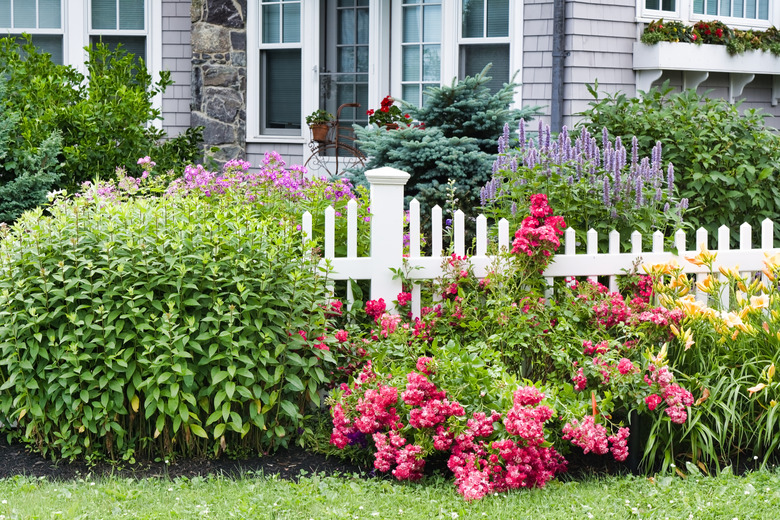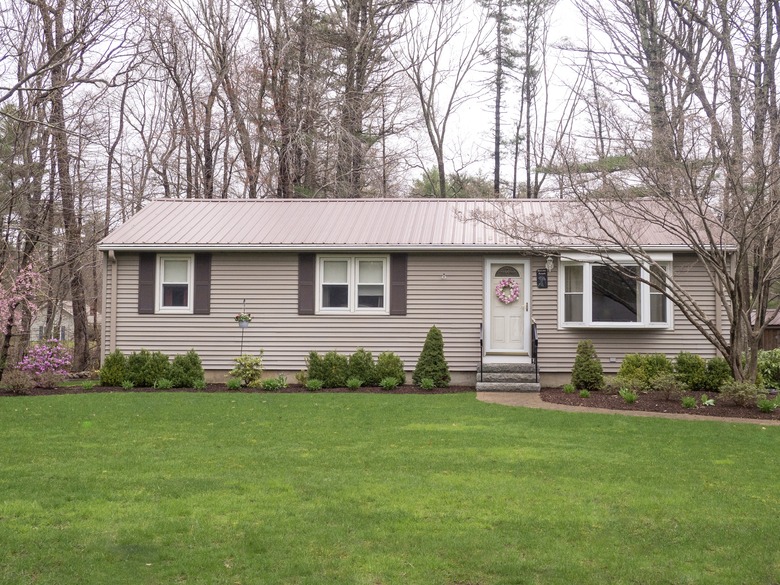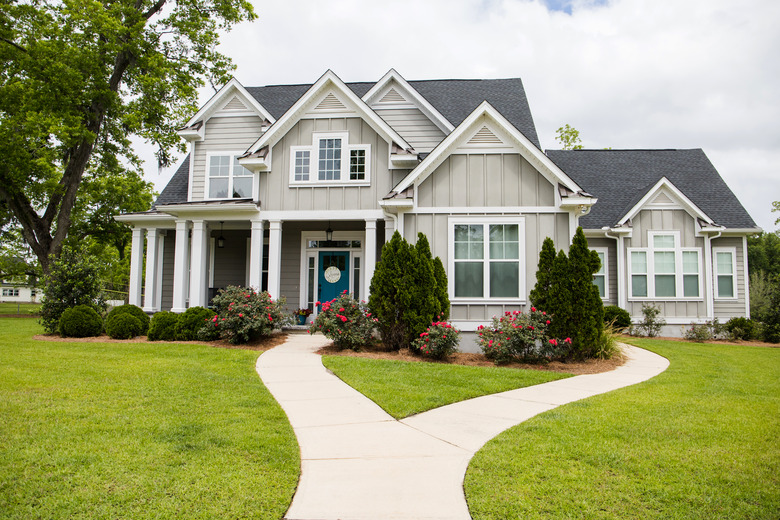Front Yard Landscaping Tips
We may receive a commission on purchases made from links.
The front yard landscaping is the first thing others notice as they approach your home, even before they can get a good look at the house. While there are no hard and set rules that apply to every front yard, a few guiding principles maximize curb appeal and the overall usefulness of the space.
In many cases, less is more when it comes to coming up with front yard landscaping ideas. Start with a few small changes, see how they affect the look of the yard and then add more as you feel it is needed. Too many ornamental features in a small yard may create a busy or overgrown look while also increasing the workload required to maintain the landscape.
Plan Out Your Front Yard Landscaping
Plan Out Your Front Yard Landscaping
Before tearing out old shrubs or plotting a few flower beds, take a look at your front yard landscape from a distance, such as from the sidewalk across the street. Look from a few houses away in either direction. Snap a few photos of your front yard landscaping from several different angles as references to figure out what you like or dislike about it or to determine which areas have room for improvement. This is also a good way to determine if shrubs in front of the house appear overgrown, whether a walkway should be wider or if you have room to plant a variety of miniature ornamental trees.
Also note whether your yard's landscape design looks off balance, such as too many large plants on one side. Visual balance may be a bit hard to determine if your entryway isn't centered at the front of the house, but look for any features that seem blatantly overgrown or underdeveloped in one area compared to other parts of the yard. These are areas calling for change in your new front yard landscaping plan. If you aren't sure what looks balanced, notice what landscaping choices look great in front of houses that are similar to yours. This could give you a few clues as far as the types and sizes of plants to purchase.
Create Curb Appeal
Create Curb Appeal
A front yard's design is all about curb appeal, or how your yard looks from the street or to pedestrians strolling by. The view leading up to and including the front door is the focal point on the typical home. This area should look inviting, drawing a visitor's eyes up the walkway and toward the door. This also means any plants in front of the walkway or in front of the door's view should be low enough to not hide the door from visitors. The walkway, whether made of stone pavers or a paved sidewalk-style path, should also be free of tripping hazards and overgrown plants.
A pair of potted plants in similar size and color on either side of the steps leading to the front door immediately makes the space feel more inviting. This also draws the eye toward the front door, making it a clear focal point. As an added bonus, the plants can be swapped out each season or each year as desired. Hanging baskets of colorful blooms also add to the appeal of the front of your home with minimal labor and cost.
Local Front Yard Landscaping Regulations
Local Front Yard Landscaping Regulations
Many communities set their own rules and regulations when it comes to front yard landscaping. Some may limit the amount of pavement or nonporous surfaces covering your front yard in order to allow the ground to absorb rainwater and runoff, according to U.S. News & World Report. Other communities may not allow you to transform an entire tree lawn (the area between the street and a public sidewalk) into a pollinator flower bed or a vegetable garden, for instance.
Check your local government's website for specific requirements regarding yard landscaping. Some regulate the height of lawns and grasses as well. For instance, the city of Lakewood, Ohio states that residents could be cited if grass or weeds are 6 inches tall or higher. The ordinance doesn't mention ornamental grasses, but if a tall ornamental grass covers a majority of a small yard in such a community, the city may issue a citation. If you are unsure about a specific plant you intend to add to your yard, ask your local government first.
If you live in an area with a homeowners' association (HOA), the HOA most likely has its own rules as to what you can and can't add to your yard. In most cases, the rules require that your landscaping sticks with the theme of other homes in the community; these will vary greatly based on the region and the style of the homes. Other typical rules may ban any plants that block the view of passing motorists or cyclists, for instance. The HOA may even require an application for making any major changes to your yard's landscaping.
Determine Slope in Your Yard
Determine Slope in Your Yard
Slopes are extremely important when it comes to your home's foundation. While your yard may seem completely flat and level, it probably has a few high and low spots. These low spots cannot be near the home or guide water toward the home; otherwise, foundation issues may arise down the road. Heavy rains could cause yard flooding that leads to a wet basement, mildew or even personal property damage.
Note what happens to water during heavy rains or after a thorough watering of plants near your home. If the water runs off away from your house, that's a good sign. If it pools around the base of your home, it could be leaking inside. The yard should slope away from the home 2 to 3 inches per 10 feet or at most 1 foot per 4 feet, according to Toro. In extreme situations, you may have to remove soil from high areas, use it to fill problematic low spots and then reseed those areas of the lawn.
Find Ideal Locations for Plants
Find Ideal Locations for Plants
Some plants simply don't do well with too much shade. The same plant your across-the-street neighbors have may not grow as quickly (if at all) in your front yard if your flower bed doesn't receive much sunlight. Likewise, a shade-loving plant may find full sun every day a bit too much to handle.
Take a good look at your front yard several times on the same sunny day to notice which areas stay shady all day long, which receive some sun and some shade and which receive nearly full sun for most of the day. This makes it a lot easier to decide what plants may thrive in each area. Purchase perennials in medium sizes for the central areas of the flower beds in front of the home based on the shade and sun those flower beds receive. Choose a taller plant or two if desired to position behind the medium-sized ones.
Low-growing annuals or perennials provide colorful coverage for the fronts of the flower beds. Plants such as creeping phlox (Phlox subulata, USDA zones 3-9) spread out as they grow, offering blankets of colorful flowers that spill into surrounding areas. These also soften the look around hardscaping, such as stone, brick or concrete elements in your yard. Create a balanced look with your most colorful, most visible plants by planting swaths of the same color or same type of plant on both sides of the walkway. Perfect symmetry isn't necessary, but the overall effect should be visibly pleasing and purposeful.
Light and Wildlife Considerations
Light and Wildlife Considerations
Landscape lights add extra impact to your home's curb appeal. Sets of matching solar lights are an excellent option; since there are no wires, you're free to space them and place them wherever they add the most impact. Light the edges of the flower bed in front of the house or line up the lights symmetrically along both sides of a straight stone pathway leading to the front door. As an added benefit, they provide ample lighting for a footpath for visitors or for walks after dark.
If you live in an area visited by lots of wildlife, you may also want to think twice about the plants you choose. For instance, hosta plants (Hosta spp., zones 3-9) are a favorite for many flower beds, but they're also a deer's favorite snack. If you live in an area where deer trek through your yard, you may want to choose deer-resistant plants.
On the other hand, pollinators such as bees, hummingbirds and butterflies benefit the earth greatly, and without them, most fruits and vegetables wouldn't grow. Add plants such as a butterfly bush (Buddleja davidii, zones 5-9) to your flower beds to attract and help pollinators passing by. Many pollinator-friendly plants, such as the butterfly bush, also produce gorgeous and fragrant blooms. They look stunning outside a dining room window, offering a gorgeous view especially as butterflies visit the blooms.
Plan for Yard Maintenance
Plan for Yard Maintenance
When picking out plants or even when planning flower beds, consider the amount of maintenance each area might need. If you can't or don't want to spend a lot of time weeding, trimming and otherwise tending to plants, pick slow-growing, low-maintenance species that do well on their own in your climate. Species that are considered invasive in some areas may have to be cut back and thinned frequently to keep them from overtaking your yard.
If your yard is huge and you'd like to cut down the areas you have to mow each week, small rock gardens around the perimeters of trees reduce the amount of grass in the yard. Just be sure to put down a weed barrier before adding landscaping rocks, or you'll spend even more effort plucking weeds from between the stones.
Consider Long-Term Yard Plans
Consider Long-Term Yard Plans
When considering shrubs and trees that could last for decades, read up on them thoroughly before making final decisions. For instance, medium-sized shrubs placed in front of the porch or windows may be just the right size now, but in a few years, they'll obstruct your view. The older such shrubs become, the harder it is to trim them down to a manageable size. It also becomes harder and harder to remove their roots should you decide the plants have grown too tall.
Trees require potentially even more thought. While tall trees with full foliage provide shade and do a lot to frame the view of your home, planting them too close to the house could result in broken pipes, a cracked foundation or lifting pavement on a walkway or driveway. Read up on any tree selection you're considering to determine whether its height and root structure in five to 10 years will work well based on where you intend to plant the trees.
While some ornamental trees such as flowering dogwood (Cornus florida, zones 5-9) and weeping Japanese maples (Acer palmatum var. dissectum, zones 5-8) may not offer privacy in fall and winter because they're deciduous, they look stunning in a front yard, adding visual interest when placed off to one side of the home or out in the yard a bit, surrounded by a rock garden. Flowering dogwoods offer pleasing pink or white blooms in spring, while the leaves on some Japanese maple selections maintain a beautiful crimson to maroon color from the moment the trees leaf out. As with other plants, be sure the area you've selected provides the amount of sun or shade your chosen tree variety requires.
References
- U.S. News & World Report: 10 Home Landscaping Rules You Should Never Break
- City of Lakewood, Ohio: Litter Control, High Grass, Weeds
- Toro: Fixing Grade Problems in Your Lawn
- Mr. Maple: How To Design Your Garden with Japanese Maples
- Missouri Botanical Garden: Small Trees for St. Louis
- Missouri Botanical Garden: Cornus Florida 'Red Pygmy'
- Direct Gardening: Creeping Phlox
- Missouri Botanical Garden: Hosta 'Sum and Substance'
- Missouri Botanical Garden: Buddleja davidii



